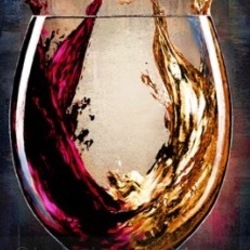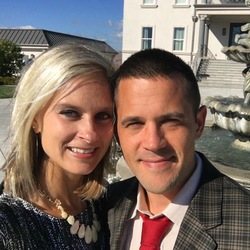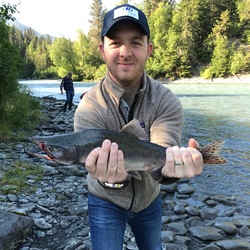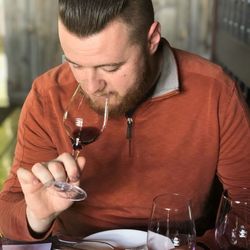Spare Key Winery
Domaine Tempier
Bandol Rosé Blend 2011
Medium deep pink moving toward reddish orange. Citrus melange aroma... orange, blood orange, sour key lime and pink grapefruit. Powerful weight on the palate but round and creamy in texture. The finish is awesome—long, sweet, savory, lasting almost a minute... with just the slightest hint of funky, cheesy forest-floor. Perfect foil for fresh broiled salmon with grilled broccoli and a Dijon cream sauce. So very glad I kept this wine so long before popping... far from over the hill.. could see enjoying the wine at 25 years. What a wonderful pink wine! — 4 years ago
Henriot
Brut Souverain Champagne Blend
A lovely Champagne that never tries to get beyond itself. Persistent small bubbles that never seem to stop with a fine mousse. Fresh brioche, apricots, and tart apples comprise the nose. Consistency is key here. This little sparkler is so solid and sturdy. Beautifully balanced, delivers at a high level that’s easily comparable to other big Champagne houses. Predominantly Chardonnay, there is a freshness and effervescence to these bubbles. Very bright and lively on the tongue, this is clearly a step above similar bottlings. Toasted almonds and toasted bread lead on the palate with vanilla and green apples bring up the rear. Such a solid, terrific Champagne, this should be your house bubbles. — 5 years ago
Merry Edwards
Russian River Valley Sauvignon Blanc 2017
Aromas of buttered popcorn that blew off to butter, citrus and white flowers. Viscous wine that coats the mouth, but not in an unpleasant way. Bright key lime and other citrus with fresh mineral crispness. Definitely some oak influence, but not the primary like with a chard — 6 years ago


Krug
Grande Cuvée Brut Champagne Blend
Erna Schein
Spare Me Napa Valley Cabernet Sauvignon 2009
2009. This wine definitely benefited from some time in the decanter! Oaky aromas turned into dark berry fruits and smooth tannins. Went great with a cast iron pan seared t-bone with shitakes. — 8 years ago
Florida Orange Groves
Key Limen Key Lime Wine
Sweet. Pretty lime-y. Tastes like Florida. — 8 years ago
Marchesi Antinori
Tignanello Toscana Super Tuscan Blend 1981
🏅 Rating 93+/100 (4,35⭐)
Tasted from magnum.
Ruby color with tawny hue showing the age. First nose has a slight touch of iron. Fruit is ripe and sweet. Vegetable scent of tomato stems suggesting presence of Cabernet Sauvignon. Sandy tannins of Sangiovese. Amazing how bottle aging makes the wine so smooth and satin.
Mostly tertiary aromas, but very well holding the age and could last for at least 5 more years without any signs of decline
Elegant expression of famous Tignanello.
1981 was outshadowed by great 1982. It was 10th anniversary vintage and is considered a very fine one.
Key oenological data:
Average sugar content of grapes at harvest 21.00%
Average total acidity of the grapes 7.80%
Alcohol content after fermentation 13.00
Average fermentation temperature 28C
Length of fermentation 13 days
Acidity of wine after malo 5.90
Ageing in 225 litre barrels 20 months
Bottle ageing in our cellars 18 months
======
I have published the article with a story of Tignanello, the emblematic SuperTuscan wine from Antinori.
\- What were the key factors of its success?
\- What makes this wine stand out from many other wines form Tuscany?
Best enjoyed with a glass of Tignanello.
Read the full article at www.stasmedvedev.lv/wine
---
Instagram: @wine_talks_club — 4 years ago
Raul Pérez
Ultreia Saint Jacques Mencía
Heady nose of blackberries, jammy purple fruit, brambly and peppery aromas, and then surprisingly lifted on the palate. Sappy with a uniquely Spanish garrigue quality. Refined in its structure and reminiscent of cru Beaujolais in the realm of brouilly or moulin a vent... but at 15 years ago prices. Such a generous wine! Plenty of freshness, spice and raw pleasure to spare. — 5 years ago

Rock View
Reserve Chardonnay 2017
Bright yellow gold. Inviting nose of yellow apple ale lightly buttered popcorn. Medium full bodied palate echoes the nose with medium plus acidity. Balance is key. Buttery to be sure, but everything else is there too. If you like the classic California style, this gives it in spades. Pair with lobster, roast chicken, or cream sauces. — 6 years ago
Forge Cellars
Finger Lakes Riesling 2013
Nice citrus notes—lemon and key lime. Petrol, rubber. Crisp acidity. Really well balanced right now. — 7 years ago
Sinegal Estate
Reserve Cabernet Sauvignon Blend 2016
Of the Napa wines I tasted over 4 days on this trip, the 16 Sinegal Reserve & the 13 Seavey Cabernet were my favorites. Both great wines but, stylistically very different. The Seavy big and bold and the Sinegal pure beauty & elegance.
The nose reveals very dark currants. Dark & milk chocolate. Blackberries, creamy black raspberries, black plum & plum, mocha powder, core of anise, beautiful dark spice, soft volcanic soils, some dry brush and lavender, violets and fresh dark red florals.
The body is full. The tannins are really meaty but, exceptionally soft, fine and meaty. Lots of dark spice with plenty of heat. The mouthfeel is gorgeously sexy with feminine elegance. Dark & milk chocolate. Blackberries, creamy black raspberries, black plum & plum, mocha powder, core of anise, beautiful dark spice, big sweet tarry notes, soft volcanic soils, some dry brush, lavender, violets and fresh dark red florals. The acidity is perfect. The finish is well balanced sexy and gorgeous. The structure, tension say this needs to cellar eight to ten years.
Photos of; tasting cellar area, modern stainless tanks, outside terrace tasting and or dining area and their grounds and lake.
Producer history and notes...Sinegal Estate was founded in 2013 with wines made from their 30 acre Inglewood estate in St Helena (not to be confused with the Inglenook Estate in Rutherford). This is not a new property, it was part of an original land grant and its more modern day history dates back to 1879 when owner Alton Williams purchased the property and planted the first vines in 1881.
The property has changed owners a number of times over the decades. At one point the Jaegers’ owned the estate, Bill Jaeger and his wife Lila lived here. These Napa Valley pioneers were in part responsible for helping establish Freemark Abbey and Rutherford Hill. Lila was also a gardener and established beautiful gardens on the property.
Owners, David (father)and James (son) Sinegal purchased the property in 2013. James was the co-founder of Costco and once CEO. David worked at Costco for 21 years.
After the purchase, David divided each of their vineyards into smaller blocks, picking selectively (30 times in 2013) rather than all at once, and adding technology to the vineyards so they have up to the date reports on a number of data points including temperatures, soil moisture and various barometric pressures. If they want to selectively water, say vine #67 in row number three, they can do so with their irrigation system. Extremely efficient!
Nine acres of vines are planted to various red varietals including; Cabernet Sauvignon, Cabernet Franc, Malbec and Petit Verdot. They have some of the older Cabernet Franc vines in the valley that are 30+ years old.
The soils here are diverse and can vary even within small geographic ranges on the property. Some of their vineyards are planted on the valley floor – while their upper vineyards are hillside, on the edges of the Mayacamas Mountains.
Their landscape above the property is interesting and part of the Mayacamas Mountains. Visually, it appears drier than other parts of this mountain range and the vegetation reflects that with grey pine and more open natural vegetation rather than the thicker wooded vegetation more commonly associated with parts of Spring and Diamond Mountains to the north.
After purchasing the property, David created planned and laid out his vision to create a world-class boutique wine making operation. Many wineries in the Napa Valley can take years before they come to fruition, not so here. After only about 10 months, the existing winery was remodeled. 6,500 feet of caves were expanded and drilled into the hillside behind the winery and a new hospitality center was built. The hospitality center ties in very well with the winery. From the small tasting room, large doors open revealing the tanks.
A vegetable garden slightly under an acre grows just south of the winery building. Vegetables from this garden are sold to nearby restaurants.
A skeleton key appears on the labels of their wine and is prominently displayed on the outside of their winery building. This has historical significance. The original key opens the front door to the historic home on site and is displayed in the tasting room. With respect to the history of this property, this one key has already become iconic to the brand.
You only need to look inside of the winery to see that their wine making team is focused on quality. Each of the small lot tanks have built in pumps which can be controlled and programmed to do pump-overs anytime of the day or night. In addition, these tanks have multiple points at which the temperature can be controlled. These tanks do not necessarily handle all their fermentation’s. They also ferment small lots in puncheons and barrels as needed. Control across the board is the key here and it is the control of the details in wine making that is is so integral from when the fruit first arrives through to when it is bottled.
2013 was their inaugural release. The focus is currently on two primary varietals, Sauvignon Blanc and Cabernet Sauvignon. The 2013 Sauvignon Blanc were sourced from the estate but, then it was determined it was growing in an area better suited for red varietals so it was torn up and new plantings were made in the back of the property. While not far from these original plantings, their new home for their Sauvignon Blanc features different soils and is growing in a cooler part of the property.
The wine making team has been experimenting with the style of this varietal since 2013 with subsequent vintages seeing more oak. Especially, using the slightly longer cigar shaped barrels , which have extra surface area for maximizing complexities including textural feel imparted from aging the wine on the lees in these particular barrels. Maceration on the red wines is often 8-10 days and sometimes up to 20 days.
Most of their sales are direct to visitors or through their mailing list. However, they do have some distribution outside California in Florida, New York and Washington. Primarily to restaurants. — 7 years ago


Ravines Wine Cellars
White Springs Vineyard Dry Riesling 2017
A pre-dinner bottle while we do meal prep tonight.
Prior notes still apply:
Nose has lime zest, lime juice, green hay, wet granite/limestone pebbles, oxidized green apple peel, polyethylene tubing and tangerine peel.
Palate has Key lime flesh, cold tangerine slice, apricot skin, wet-pulverized limestone, lemongrass, tangerine zest, (minor) dried apricot and light honey on the medium finish, medium acid, great balance. — 4 years ago
Louis Roederer
Brut Premier Champagne Blend
Peach, key lime pie, Fuji apple, and brioche on the clean crisp nose. Fine creamy mousses lead to a supple and elegant palate. Fresh acidity and hint of chalky minerals.
For about the same price, I prefer Charles Heidseick NV bottling for its complexity and intensity. — 5 years ago
Sandhi Wines
Sanford & Benedict Chardonnay 2012
II’ve loved all the Sandhi 2012 range of whites & this £65 S&B is superb 👍 Paired with enough curry to get a small village going regular for a week 🤣 💨 sorry I didn’t take pics of that feast 😁
📍 Sandhi Sandford & Benedict Santa Rita Hills Chardonnay 2012 @sandhiwines
🏵 94 points
🍷 Golden yellow
👃 Chopped pineapple, crushed rock mineral, lemon oil, key lime pie, honey gloop & white jasmine flowers w/ light oak, vanilla & apple
👄 Med+ body of creamy refreshing clean tropical & citrus yummyness without being overly syrupy & a hit of green apple, pineapple, honey & minerality in med acidity
🎯 Med+ fresh apple, citrus & tropical trickle w/ a dry mineral honeyed pineapple slapette — 6 years ago
Grosset
Polish Hill Clare Valley Riesling 2016
Château Doisy-Daëne
Bordeaux Sec Sémillon-Sauvignon Blanc 2015
For someone known for their sweet wines from Barsac, a 94 pt critique from Wine Spectator on a Sec is awesome for them, and I almost agree in my critique. It has a very fragrant nose of white flowers, beeswax, kiwi, and lime zest. The pallet is very zesty, and bright, exhibiting notes of grapefruit, key lime, honeysuckle, vanilla, and a bright mouthwatering acidity to the finish. Lovely and refreshing, but would most certainly see some lovely age. I'd like to lay this vintage down and see what 10 years would do for it. Yum! — 8 years ago



















Nicole Ruiz Hudson
Fun, spritzy, refreshing .
Nose: lime skin, grapefruit, fresh white flowers and stones.
Palate: similar with green pear, white peach, key lime, and spritzy lift. — 4 years ago